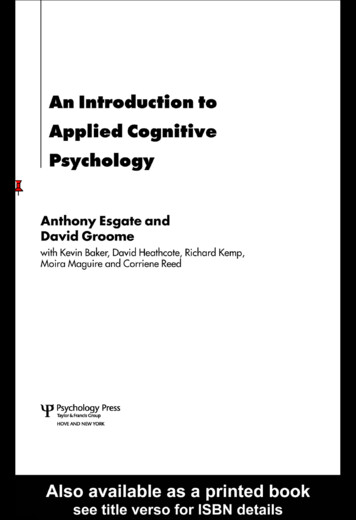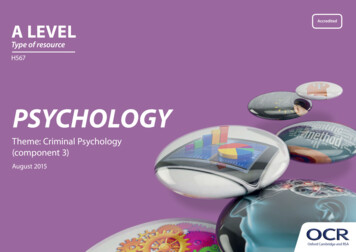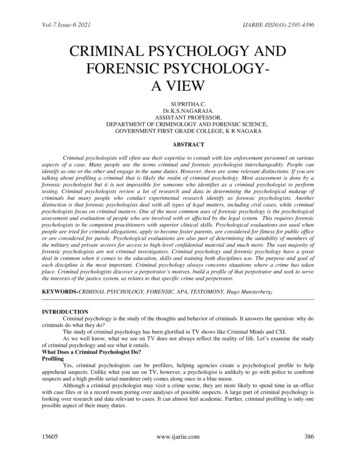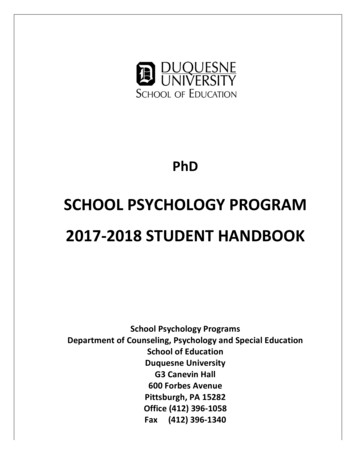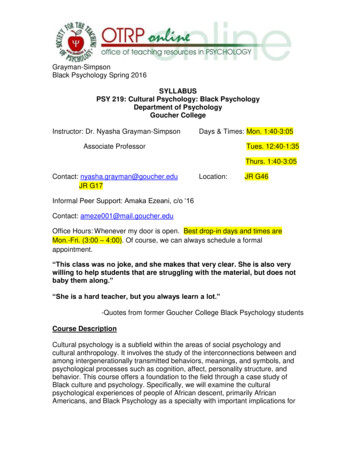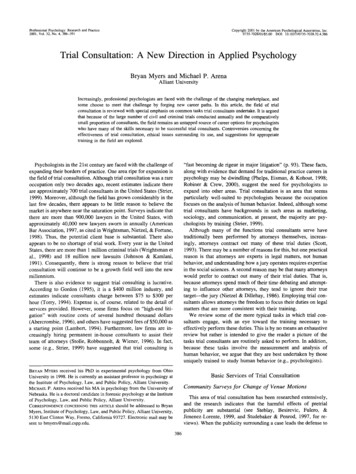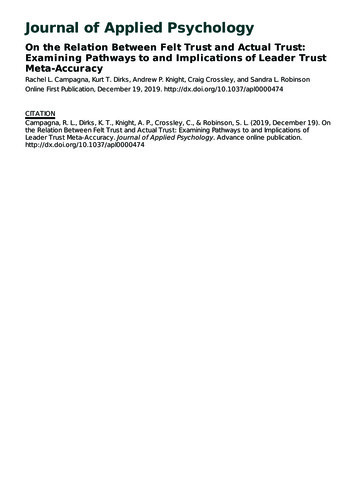
Transcription
Journal of Applied PsychologyOn the Relation Between Felt Trust and Actual Trust:Examining Pathways to and Implications of Leader TrustMeta-AccuracyRachel L. Campagna, Kurt T. Dirks, Andrew P. Knight, Craig Crossley, and Sandra L. RobinsonOnline First Publication, December 19, 2019. na, R. L., Dirks, K. T., Knight, A. P., Crossley, C., & Robinson, S. L. (2019, December 19). Onthe Relation Between Felt Trust and Actual Trust: Examining Pathways to and Implications ofLeader Trust Meta-Accuracy. Journal of Applied Psychology. Advance online publication.http://dx.doi.org/10.1037/apl0000474
Journal of Applied Psychology 2019 American Psychological AssociationISSN: 0021-90102019, Vol. 1, No. 999, 000http://dx.doi.org/10.1037/apl0000474This document is copyrighted by the American Psychological Association or one of its allied publishers.This article is intended solely for the personal use of the individual user and is not to be disseminated broadly.On the Relation Between Felt Trust and Actual Trust: Examining Pathwaysto and Implications of Leader Trust Meta-AccuracyRachel L. CampagnaKurt T. Dirks and Andrew P. KnightUniversity of New HampshireWashington University in St. LouisCraig CrossleySandra L. RobinsonUniversity of Central FloridaUniversity of British ColumbiaResearch has long emphasized that being trusted is a central concern for leaders (Dirks & Ferrin, 2002),but an interesting and important question left unexplored is whether leaders feel trusted by eachemployee, and whether their felt trust is accurate. Across 2 field studies, we examined the factors thatshape the accuracy of leaders’ felt trust— or, their trust meta-accuracy—and the implications of trustmeta-accuracy for the degree of relationship conflict between leaders and their employees. By integratingresearch on trust and interpersonal perception, we developed and tested hypotheses based on 2 theoreticalmechanisms—an external signaling mechanism and an internal presumed reciprocity mechanism—thattheory suggests shape leaders’ trust meta-accuracy. In contrast to the existing literature on felt trust, ourresults reveal that leader trust meta-accuracy is shaped by an internal mechanism and the presumedreciprocity of trust relationships. We further find that whether trust meta-accuracy is associated withpositive relational outcomes for leaders depends upon the level of an employee’s actual trust in the leader.Our research contributes to burgeoning interest in felt trust by elucidating the mechanisms underlyingtrust meta-accuracy and suggesting practical directions for leaders who seek to accurately understandhow much their employees trust them.Keywords: trust, felt trust, meta-accuracy, metaperception, leaderwithin relationships, identifying key drivers of trust formation andthe psychological processes that underlie it (e.g., Lewicki, Tomlinson, & Gillespie, 2006).Having established that being trusted by others is valuable foremployees and leaders, and with an improved understanding of itsantecedents, researchers have recently begun to explore the phenomenon of feeling trusted by others (e.g., Baer et al., 2015; Lau,Lam, & Wen, 2014; Salamon & Robinson, 2008). Feeling trusted,or felt trust, reflects the degree to which one person believes thatanother person trusts them. Existing research suggests that felttrust can motivate organizational members to perform at a highlevel (Baer et al., 2015; Lau et al., 2014; Salamon & Robinson,2008) and be more likely to incur personal costs to maintain thatfelt trust (Campagna, Mislin, & Bottom, 2019). Thus, evidencesuggests that individuals act upon and respond to felt trust.An interesting and important question, however, is whether felttrust reflects the actual trust that exists in the relationship. Areorganizational members able to accurately assess whether they aretrusted? An untested assumption underlying research on felt trustis that one person’s felt trust is shaped by the actual trust held bya counterpart and expressed through the counterpart’s behavior.For example, Baer et al. (2015) suggested that an employee’s felttrust develops in response to behavioral manifestations of a supervisors’ actual trust, such as the delegation of critical tasks ordisclosure of sensitive information. Lau et al. (2014, p. 112)asserted that, although they are different concepts, “trust and felt“One of the hardest things for leaders to do is to understand how otherpeople see them . . .” Bill George, Former CEO of Medtronic (George,2016).Trust has become a central concept in organizational researchand, across time, researchers’ efforts have progressed through alogical series of questions regarding trust. After defining the construct and delineating its theoretical bases, researchers focused onassessing the importance of trust in the workplace, finding thattrust is associated with a range of important outcomes, includingteamwork and leadership effectiveness (e.g., Colquitt, Scott, &LePine, 2007; Dirks & Ferrin, 2002; Mayer, Davis, & Schoorman,1995; McAllister, 1995). Recognizing its significance, researchersthen turned attention to understanding how trust is establishedX Rachel L. Campagna, Peter T. Paul College of Business and Economics, University of New Hampshire; Kurt T. Dirks and Andrew P.Knight, Olin Business School, Washington University in St. Louis; CraigCrossley, Department of Management, University of Central Florida; Sandra L. Robinson, Sauder School of Business, University of British Columbia.Correspondence concerning this article should be addressed to Rachel L.Campagna, Peter T. Paul College of Business and Economics, Universityof New Hampshire, 10 Garrison Road, Durham, NH 03824. E-mail:rachel.campagna@unh.edu1
This document is copyrighted by the American Psychological Association or one of its allied publishers.This article is intended solely for the personal use of the individual user and is not to be disseminated broadly.2CAMPAGNA, DIRKS, KNIGHT, CROSSLEY, AND ROBINSONtrust are very often related” and are “two sides of the same coin”(p. 114). As a result, employees and leaders would presumablywant their felt trust to be accurate—to know who trusts them andwho does not—so that they can act appropriately. Likewise, whileleaders are advised to demonstrate their trust so that employeeswill know they are trusted, this advice is only useful if employeesassess those signals accurately (e.g., Baer et al., 2015; Nerstad etal., 2018; Salamon & Robinson, 2008). Recognizing this issue,researchers have suggested that a logical next step in investigationsof felt trust is to examine the relationship between actual trust andfelt trust (Lau et al., 2014; Salamon & Robinson, 2008).The current article addresses this issue by integrating theoreticalinsights from literatures on trust and interpersonal perception tocritically examine the degree to which a leader’s felt trust corresponds to actual employee trust and why the two may diverge. Todo so, we offer a conceptualization of the relation between felt andactual trust that is rooted in the more general social psychologyliterature on interpersonal perception (e.g., Carlson & Kenny,2012; Kenny & DePaulo, 1993). Viewed from this perspective, felttrust is the outcome of one person’s error-prone attempt to accurately understand the perception held by another person (i.e., theother person’s actual trust). Drawing from this literature, we develop and test predictions about factors that may increase ordecrease the accuracy with which one person (i.e., a leader) understands another person’s (i.e., an employee’s) trust and examinewhy this matters for the relationship between the two.This article makes several contributions to the literature on trust.First, our findings challenge two presumptions of existing work onfelt trust—that felt trust is inherently linked to a counterpart’sactual trust and that observed interpersonal behavior creates alinkage between the two. Grounded in the more general literatureon interpersonal perception (e.g., Carlson & Kenny, 2012; Kenny& DePaulo, 1993), we consider how two different psychologicalmechanisms might shape how accurate people are in understanding how much others trust them. Rather than accurately interpreting another person’s observable behavior as signals of their trueunderlying trust—the presumed mechanism in existing theory andresearch on felt trust (e.g., Baer et al., 2015; Lau et al., 2014;Nerstad et al., 2018; Salamon & Robinson, 2008)— our findingssuggest that an accurate sense of felt trust instead emerges whensomeone uses their own trust as the basis for assessing how muchanother person trusts them by presuming that trust relationships arereciprocal. Thus, the findings underscore an important point regarding how leaders develop an accurate assessment of trust andthe limitations of relying on the behavioral signals they observe.Second, our findings extend existing research on felt trust withinorganizations in two ways. In contrast to existing research that hasfocused on employees feeling trusted by leaders, we consider theimplications of leaders feeling trusted by employees. Felt trustshould be important to leaders, and we argue that the accuracy oftheir felt trust may be particularly valuable. Whereas prior researchon felt trust has considered its implications for individual outcomes like job performance and emotional exhaustion (e.g., Baeret al., 2015), our theoretical development and empirical findingssuggest that felt trust also has important implications for interpersonal outcomes, such as the degree of relationship conflict betweentwo people. Understanding how felt trust accuracy relates to conflict is important, given the adverse effects of conflict with employees for leaders (de Dreu, Van Dierendonck, & Dijkstra, 2004;Thomas, 1992). By relaxing the assumption that felt trust is necessarily an accurate reflection of actual trust, we suggest that theinterpersonal implications of felt trust depend upon the degree towhich felt trust and actual trust are aligned (Brion, Lount, &Doyle, 2015). In addition to cultivating and managing the level offelt trust that someone feels in an organization, our findings pointto the importance of cultivating and managing the accuracy ofsomeone’s felt trust.We begin by integrating the general literature on interpersonalperception with the literature on felt trust to outline two theoreticalmechanisms that might underlie the accuracy of a leader’s felttrust. We develop and test predictions that logically flow fromthese mechanisms in Study 1—an investigation of leaders andemployees working within a state corrections department who areentrusted with supervising convicted felons. We conceptually replicate and extend the findings of Study 1 in Study 2—an examination of leaders and employees working in a nonprofit caregivingorganization who are charged with supporting individuals withneurological and cognitive impairments. In addition, Study 2 testspredictions about the implications of accuracy for relationshipconflict.Theoretical FrameworkTrust—“a psychological state comprising the intention to acceptvulnerability based upon positive expectations of the intentions orbehavior of another” (Rousseau, Sitkin, Burt, & Camerer, 1998, p.395)— has a long history in the organizational literature. Theconcept of felt trust is, however, newer. Felt trust refers to thedegree to which a person believes he or she is trusted by anotherperson (Baer et al., 2015; Salamon & Robinson, 2008). Just as theconcept of trust is relational, such that trust inherently requires atarget (e.g., John trusts Mary), so too is the concept of felt trustrelational (e.g., Mary feels trusted by John). The target for felt trustcan be a group (e.g., Salamon & Robinson, 2008) or an individualemployee (e.g., Lau et al., 2014). In this article, we focus specifically on a leader’s felt trust at the dyad-level, such that felt trustis a leader’s belief that a given employee is willing to make herselfvulnerable to the leader.To advance our understanding of felt trust, we draw from thegeneral literature on interpersonal perception (e.g., Carlson &Kenny, 2012; DePaulo, Kenny, Hoover, Webb, & Oliver, 1987;Kenny, 1994; Kenny & DePaulo, 1993). This literature has longsought to understand how accurately people understand others’perceptions of them. The concept of felt trust reflects what themore general interpersonal perception literature refers to as adyadic metaperception— one person’s belief about the thought,attitude, or perception held by another person (Kenny, 1994).Importantly, and unlike existing theory and research on felt trust,the more general literature on interpersonal perception does notpresume that a metaperception is an accurate reflection of the otherperson’s true thought, attitude, or perception. Instead, a derivativeconcept that is the focus of significant research in the literature oninterpersonal perception is the concept of dyadic meta-accuracy—the degree of alignment between one person’s metaperception andthe actual thought, attitude, or perception held by another person(Kenny & DePaulo, 1993).Grounded in the literature on interpersonal perception, the degree of alignment between one person’s felt trust and a counter-
This document is copyrighted by the American Psychological Association or one of its allied publishers.This article is intended solely for the personal use of the individual user and is not to be disseminated broadly.LEADER TRUST META-ACCURACYpart’s actual trust is dyadic trust meta-accuracy (i.e., How muchdoes Mary’s felt trust match John’s actual trust of Mary?; Brion etal., 2015). Like any form of accuracy, the degree of trust metaaccuracy can be described in either absolute or directional terms.In absolute terms, accuracy reflects the separation, or distance,between one person’s felt trust and another person’s actual trust. Indirectional terms, accuracy reflects the degree to which one person’s felt trust over- or underestimates another person’s actualtrust. Theoretically, when leaders accurately understand an employee’s trust in them—that is, when there is a minimal gapbetween felt trust and actual trust—they are equipped to behave inways that build or restore weak or broken trust, as well as meet theemployee’s expectations and ensure smooth interpersonal interactions (Brion et al., 2015). But what might enable a leader todevelop an accurate understanding of an employee’s trust? Answering this question—and developing predictions about the antecedents of trust meta-accuracy—requires an account of howleaders’ felt trust forms in the first place.Theory and research (e.g., DePaulo et al., 1987; Eisenkraft,Elfenbein, & Kopelman, 2017; Kenny & DePaulo, 1993) describetwo different theoretical pathways through which people formmetaperceptions. These pathways have historical roots in differentliterature streams and, consequently, provide different explanations for why leaders may be relatively accurate or inaccurate intheir understanding of how much an employee trusts them. Inparticular, these two pathways highlight different sources of information that people use when forming their understanding of whatanother person thinks. The first—an external pathway— has rootsin an interpersonal relations tradition that describes people aslooking outward, using others’ observable behavior to understandtheir perceptions and attitudes (e.g., Funder, 1987; Kenny & Albright, 1987). The second—an internal pathway— has roots in acognitive tradition that portrays people as turning inward, relyingon their own perceptions and feelings, in conjunction with cognitive heuristics, to form their beliefs about other people’s perceptions and attitudes (e.g., Carlson & Kenny, 2012; De Soto &Kuethe, 1958, 1959; Heider, 1958). These pathways are not mutually exclusive; rather, each represents a different channel ofinformation that people can use when forming a metaperception(Eisenkraft et al., 2017; Kenny & DePaulo, 1993); or, in thecontext of our article, a leader’s felt trust.The External Pathway: Trust Meta-Accuracy IsShaped by One’s Interpretation of Another’s BehaviorThe external pathway for trust meta-accuracy suggests thatleaders develop felt trust by directly observing and interpreting anemployee’s verbal and nonverbal behaviors as cues or signals ofthe employee’s trust (Kenny & DePaulo, 1993). Longstandingtheories of trust are steeped in observation and interpretation ofothers’ behavior as a foundation of trust and vulnerability. Forinstance, Lewicki and Bunker (1996) suggested early stages oftrust are formed as a “calculus” or expectation based on another’sprior behavioral cues. To the extent that researchers studying felttrust have commented on its origins, they have also presumed it toform through this external mechanism. For example, Nerstad et al.(2018) stated that employee felt trust stems from cues and signalssent by one person that convey trust in another. This is consistentwith Baer et al. (2015, p. 1639), who concluded from a series of3interviews that employees use observable behavior “. . . as signalsof their supervisors’ trust in them.” Similarly, Lau, Liu, and Fu(2007) suggested that employees interpret a leader’s delegation ormonitoring behavior as signals of how much their leader truststhem.Developing predictions for this external pathway to trust metaaccuracy requires considering attributes of both the person sendingsocial information (i.e., in our case, the employee) and the personreceiving and interpreting this social information (i.e., in our case,the leader). The logic underlying the external pathway implies thata leader’s trust meta-accuracy is likely to be high when (a) theemployee’s observable behavior is a true representation of his orher actual trust in the leader, and/or (b) the leader is a skilledinterpreter of the underlying meaning of the employee’s behavior.Conversely, a leader is likely to develop an inaccurate understanding of an employee’s trust when (a) the employee’s observablebehavior diverges from his or her actual trust, and/or (b) the leadermisinterprets the meaning of the signals that an employee sends.We consider each of these two factors in postulating whether aleader’s felt trust aligns with an employee’s actual trust.With respect to employees and the signal-sending component,any attribute that disconnects an employee’s observable behaviorfrom his or her true feelings of trust would curtail leader trustmeta-accuracy. An attribute that likely distorts the veracity ofsocial signals is employee self-monitoring—an individual tendencyto monitor situations and to control or modify one’s expressedbehavior to be socially appropriate (Snyder, 1974). Self-monitoring islikely associated with an employee’s tendency to express a falsesense of trust for the leader (Caldwell & O’Reilly, 1982), whichwould reduce a leader’s trust meta-accuracy. Those who are highin self-monitoring are often referred to as social chameleons because they alter their external self-presentation to match the normsand expectations of others in different situations in order to beviewed positively by others (DePaulo et al., 1987; Kilduff & Day,1994). In contrast, the observable behaviors of those low in selfmonitoring are driven more by their own internal feelings andattitudes (Snyder, 1979). Self-monitoring is thus akin to a filterthrough which an employee’s true internal feelings and beliefsmust pass before they are expressed as external signals to a leader.Within the context of a leader– employee relationship, selfmonitoring likely filters out behavior that would signal a lack oftrust in a leader, with employees high in self-monitoring behavingin ways that signal to their leader a sense of trust and withholdingbehaviors that would indicate feelings of distrust. This wouldupwardly bias the cues of trust available for the leader to interpretwhen forming a sense of felt trust and contribute to an overestimation of an employee’s trust.Hypothesis 1a: Employee self-monitoring is negatively related to dyadic leader trust meta-accuracy, such that higheremployee self-monitoring results in a leader overestimating anemployee’s trust.With respect to leaders and the signal-receiving component ofthe external pathway, any attribute that enhances a leader’s effectiveness in interpreting the underlying intentions and feelings thatdrive others’ behavior likely improves leader trust meta-accuracy.Perspective taking—a cognitive process in which one intentionallyadopts and considers the view of another person to understand his
This document is copyrighted by the American Psychological Association or one of its allied publishers.This article is intended solely for the personal use of the individual user and is not to be disseminated broadly.4CAMPAGNA, DIRKS, KNIGHT, CROSSLEY, AND ROBINSONor her intentions, beliefs, and attitudes (Parker & Axtell, 2001)—isan attribute that may make some leaders more fine-tuned receiversand interpreters of the social signals that are diagnostic of anemployee’s trust. Leaders high in perspective taking may havesuperior decoding abilities, which may allow them to processinteractions with, and behaviors of, a given employee and use themto discern the employee’s true perceptions and feelings (Davis,1983). Because they more frequently consider others’ internalmotives and beliefs when attempting to make sense of their external behavior, leaders high in perspective taking likely interpret anemployee’s behavior in ways that more closely align with theemployee’s actual trust. Thus, perspective taking should enhance aleader’s ability to attain trust meta-accuracy.Hypothesis 1b: Leader perspective taking is positively relatedto dyadic leader trust meta-accuracy, such that higher leaderperspective taking results in a smaller discrepancy (i.e., absolute difference) between a leader’s felt trust and employee’strust.The Internal Pathway: Trust Meta-Accuracy IsShaped by One’s Own Trust in Another and thePresumption of ReciprocityIn addition to using external information when seeking to understand another person’s perception, leaders’ meta-accuracy mayalso be shaped by an internal mechanism. This internal pathwayreflects the lay theories people hold to help them make sense ofambiguous information in their social worlds (Bargh & Chartrand,1999). Classic research in social psychology and interpersonalperception has highlighted that one cognitive heuristic that peopleuse when assessing others’ feelings is presumed reciprocity (sometimes called symmetry or balance; e.g., Burnstein, 1967; Heider,1958; Kenny, 1994)—the assumption that one’s own feelings arereciprocated by another (Carlson & Kenny, 2012; De Soto, 1960;De Soto & Kuethe, 1959; Eisenkraft et al., 2017; Kenny & DePaulo, 1993; Kenny & Nasby, 1980; Zajonc & Burnstein, 1965).Although research has found support for the presumption of reciprocity, in that it decreases accuracy by introducing bias into theperception process, other research on interpersonal perception hasprovided empirical support for this pathway in shaping the accuracy with which people understand how others view them generally (e.g., Carlson & Kenny, 2012; Eisenkraft et al., 2017; Elfenbein, Eisenkraft, & Ding, 2009; Kenny, Bond, Mohr, & Horn,1996; Shectman & Kenny, 1994). Yet, notwithstanding this evidence, trust scholars have not—to our knowledge— consideredhow this internal mechanism might shape felt trust and, thus, trustmeta-accuracy.An internal pathway to trust meta-accuracy would suggest thatwhen trying to determine how much an employee trusts them, aleader would consider their own feeling of trust for an employee inconjunction with their cognitive representation of the nature oftrust relationships or their implicit assumption of how trust-basedrelationships generally function between a leader and employee.To illustrate, in their classic research on how people cognitivelyrepresent interpersonal relations, De Soto and Kuethe (1959)prompted participants with a statement about a relationship, suchas “Jane trusts John.” Then, they asked participants whether Johnalso trusts Jane, finding that participants expected, at a 73%probability, a trust-based relationship to be reciprocated by theother party. This example demonstrates that individuals’ cognitiverepresentation of trust guides their expectation for reciprocity ininterpersonal relationships. Thus, rather than only drawing fromexternal observable signals, a leader’s felt trust may be shaped bytheir assumption of reciprocity in the relationship with their employee. Whereas an employee’s trust in a leader may not beimmediately evident to the leader, a leader’s own trust for theemployee is readily accessible and can be used to infer how muchthe employee trusts him or her.Using their own view of an employee and a cognitive heuristicthat trust relationships are reciprocal can yield a relatively accuratesense of felt trust because trust relationships are, in general, trulyreciprocated (Bacharach, Guerra, & Zizzo, 2007; Kenny, 1994;Kenny & Nasby, 1980; Pillutla, Malhotra, & Murnighan, 2003).When people turn inward, consulting their own feelings about apositive interpersonal relationship with another person, the presumption of reciprocity tends to be a useful heuristic for inferringthe other person’s trust in them. Thus, we posit that a leader mayachieve trust meta-accuracy through the internal pathway involving a valid presumed reciprocity mechanism, where a leader’s trustfor his or her employee is positively related to the leader’s felttrust, which is in actuality reciprocated by the employee.Hypothesis 2: Dyadic leader trust meta-accuracy is a functionof presumed reciprocity, such that an employee’s trust in aleader is positively related to a leader’s felt trust indirectlythrough a leader’s trust in the employee.Study 1MethodProcedure and sample. We collected survey data from leaders and employees of a large state corrections department in theUnited States. Participants represented several common roles inthe department, including corrections officers, caseworkers, andprobation officers. These employees noted in informal interviewsthat accurately understanding their relationships with others iscritical in this context. One leader’s comments, for example,reflected the importance of having an accurate felt trust perception:“You realize the need to trust others and know they trust you onday one of the job. When the gates open and you are outnumberedby inmates, you have to know your people have your back.”The corrections department provided a roster of leaders andtheir employees. Needing to constrain the length of the leadersurvey— because leaders would be asked to respond to severalitems for each of their employees—we drew a sample from thisroster of all leaders and a maximum of five (randomly selected)employees per leader. Our personalized e-mail invitations yieldeda total participation of 147 leaders (98% response rate) and 373employees (78% response rate). Because our hypotheses focusedon the leader– employee pair, our final sample for conductinganalyses comprised the 213 dyadic observations (213 employeesnested within 90 unique leaders) for which we received matchedleader and employee responses.Leaders were 36% female, 92% White, with an average age of47.57 years old (SD 9.21) and average department tenure of11.57 years (SD 8.01). Employees were 43% female, 82%
This document is copyrighted by the American Psychological Association or one of its allied publishers.This article is intended solely for the personal use of the individual user and is not to be disseminated broadly.LEADER TRUST META-ACCURACYWhite, with an average age of 42.59 years (SD 11.82) anddepartment tenure of 5.72 years (SD 5.45).1Measures. Interitem reliability (i.e., Cronbach’s alpha) formultiitem survey measures is included along the diagonal inTable 1.Employee and leader trust. We used three items from Kim,Ferrin, Cooper, and Dirks (2004), which was based on Mayer andDavis (1999), using a 5-point Likert-type scale ranging from 1 strongly disagree to 5 strongly agree. Employees responded tothese items for their sole leader; leaders completed the items foreach of their employees, identified by name. A sample item is “Ifeel secure in having make decisions that critically affect me.”Leader felt trust. Leaders responded to the same root itemsthat we used to measure trust, altered to solicit their beliefs abouthow much a given employee trusted them. A sample item thatparallels the item given above is, “[Employee nam] feels secure inhaving me make decisions that critically affect him/her.”Leader trust meta-accuracy. As we explain in greater detailbelow, we assessed leader trust meta-accuracy using a multivariateapproach (Edwards, 1995). This entailed considering (a) the algebraic difference between a leader’s felt trust and the employee’strust (i.e., leader felt trust minus employee trust); (b) the absolutevalue of the algebraic difference; and, (c) each of the componentsof these difference scores (i.e., leader’s felt trust, employee’strust). We explain this approach in greater detail below.Employee self-monitoring. Employees completed Lennoxand Wolfe’s (1984) 13-item Revised Self-Monitoring scale using a7-point Likert-type scale (1 certainly always false to 7 certainly always true). A sample item is “In social situations, Ihave the ability to alter my behavior if I feel that something else iscalled for.”Leader perspective taking. Leaders completed the 7-item perspective taking subscale from the Interpersonal Reactivity Index(Davis, 1983), responding with a 6-point Likert-type scale (1 does NOT describe me well to 6 describes me well). A sampleitem is “Before criticizing somebody, I try to imagine how I wouldfeel if I were in his/her place.”Analyses. Predicting leader trust meta-accuracy—the congruence between a leader’s felt trust and an empl
dra L. Robinson, Sauder School of Business, University of British Colum-bia. Correspondence concerning this article should be addressed to Rachel L. Campagna, Peter T. Paul College of Business and Economics, University of New Hampshire, 10 Garrison Road, Durham, NH 03824. E-mail: rachel.campagna@unh.edu
